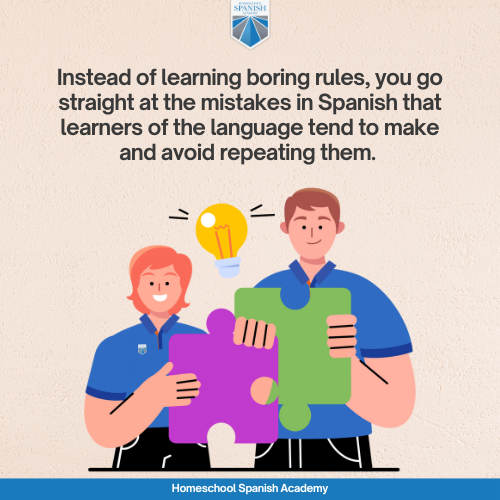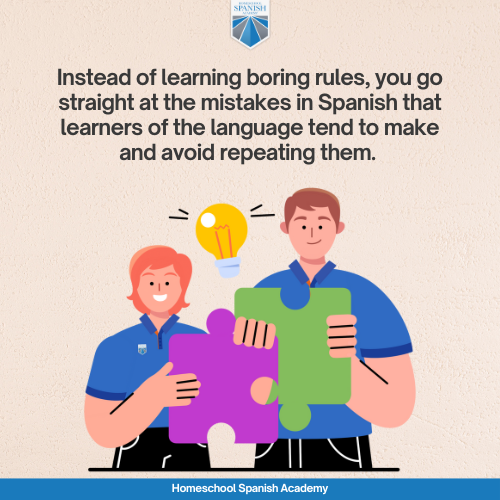Do you want to know the most common errors in Spanish grammar?
Would you like to know how to avoid them?
Well, today is your lucky day! Keep reading and find out why it’s so important to master Spanish grammar.
You’ll learn some of the most common errors in Spanish grammar, how to avoid them, and where to find valuable resources to practice grammar at home.
Join 559 million people on the planet who speak Spanish!
Sign up for your free trial Spanish class today. 
The Importance of Mastering Spanish Grammar
Although grammar has a kind of a bad rap, it is a fact that it’s “the structural foundation of our ability to express ourselves.” That applies to the written and spoken language.
Moreover, for a language learner, grammar is fundamental as without it, students “won’t know how to use [their] vocabulary, since grammar tells [them] how to combine words into sentences.”
And that applies to every language, not just Spanish. However, in Spanish, grammar plays a crucial role that can’t be ignored just for the sake of immediacy.
Or, as I like to say, trying to speak Spanish without studying its grammar is like trying to play an instrument without learning the musical notes.
It’s just not the right way to do it, and even if you somehow can do it, you won’t master your craft as you’ll be missing essential knowledge.
Common Errors in Spanish Grammar
An interesting way of learning grammar is by studying some of the most common grammar errors in Spanish.
Instead of learning boring rules, you go straight at the mistakes in Spanish that learners of the language tend to make and avoid repeating them.
Let’s see some of the most common errors in Spanish grammar:
1. Not Matching Articles, Adjectives, and Verbs to Singular and Plural
Yes, we know that this is easy when it comes to nouns, as most of the time, you only have to add an ‘s’ or ‘es’ at the end of the word, and your noun has been converted to plural.
However, remember that in Spanish, the whole sentence is affected by the number of the noun.
That means new language learners may adapt the noun but not the rest of the sentence, ending with sentences like this:
El perros negro come carne.
The black dogs eat meat.
As you can see, you won’t notice any mistakes in the translation. That’s because, in English, you don’t need to match the article, adjective, and verb to the noun number.
The correct version of that sentence would be as follows:
Los perros negros comen carne.
The black dogs eat meat.
The translation is the same, but all the parts in bold were missing in the first example, which is one of the most common errors in Spanish grammar.
Tip: To avoid this mistake, remember the verb conjugation charts and think about the correct conjugation of your verb according to your noun.
2. Not Matching Articles, Adjectives, and Verbs to the Gender of the Noun
The gender of the noun is another common Spanish mistake and one that’s closely related to the previous one.
You know that in Spanish, nouns have a gender. That means that a table (la mesa) is a feminine noun in Spanish, while a book (el libro) is masculine.
As you may have guessed by now, the gender of the noun affects the whole sentence. If you don’t do it correctly, you’ll say sentences like the one below:
Mi casa es muy bonito.
My house is very pretty.
In this case, the noun casa is feminine, but the adjective bonito doesn’t match the gender of the noun, as bonito is masculine. The correct sentence should be:
Mi casa es muy bonita.
My house is very pretty.
Again, you can see that the translation didn’t change because, in English, nouns don’t have a gender.
In this case, all you had to do was change the ending of the adjective from ‘o’ to ‘a’, but in other cases, you may have also to adapt articles.
Here’s a tip: to avoid this mistake, try including the right article every time you write a noun, as I did above when I wrote la mesa and el libro. This way, you’ll get familiarized with the gender of most nouns.
3. Having Years
This is definitely one of the most common errors in Spanish grammar. Think about how old you are and how you would say that in English.
“I am 23 years old.”
Right?
Because in English, you talk about your age. However, Spanish doesn’t work that way, and this is an excellent example of why you need to study grammar.
If you don’t, you’ll make this kind of mistake all the time because you would assume that both languages work the same way and all you need to do is translate your idea word by word.
In Spanish, you don’t talk about age, which means edad, but about years, which means años.
You are not any age years old; you “have” a number of years. This small but crucial difference creates common errors in Spanish grammar, like this sentence:
Soy 23 años viejo.
That’s the literal translation of “I’m 23 years old,” which makes no sense in Spanish. The right way to say your age in Spanish is like this:
Tengo 23 años.
I have 23 years (this is a literal but grammatically incorrect translation to English).
Here’s a tip: to avoid making this common Spanish mistake, never assume you can simply translate word by word from one language to another.
Study the basic grammar rules and think of years as things you accumulate through time (I know, it’s weird, but Spanish sometimes has these things).
4. “We Don’t Need No Education”
If you love classic rock as much as I do, I’m sure you recognize where that phrase comes from.
Exactly! It’s from the lyrics of Pink Floyd’s song “Another Brick in the Wall.” As you may know, it’s grammatically incorrect in English, where double negatives aren’t considered correct.
However, in Spanish, double negatives are accepted and even required sometimes. Moreover, you can find perfectly correct triple negatives in Spanish in certain circumstances.
So, how would this become one of the most common errors in Spanish grammar?
Well, your English tendency would make you avoid double negatives in Spanish when the correct way would be to use them. Let’s see an example:
Anoche no comí algo.
Last night, I didn’t eat anything.
This sentence is entirely wrong in Spanish, but the translation in English is correct. How do we say that in Spanish?
Anoche no comí nada.
Last night, I didn’t eat nothing (literal but grammatically incorrect translation to English).
As you can see, nada means “nothing,” making the sentence Anoche no comí nada a double negative, which in Spanish is the correct way.
To learn more about how to use double negatives, I recommend you read this article.
Tip: To avoid making this mistake, don’t mix positive and negative words in a statement, and remember that in Spanish, Pink Floyd is right.
5. “To Be or Not To Be?”
One of the most common errors in Spanish grammar is the one regarding the verb “to be” in Spanish.
As you may have heard, the verb “to be” in Spanish has two translations: ser and estar. This simple fact is responsible for a lot of trouble among new language learners.
In Spanish, sometimes you use ser, and in others, you use estar; although there are rules, they aren’t always very clear.
In this case, it has quite a few exceptions, which make it difficult for Spanish learners to discern when to use which verb. Let’s see an example:
Eres retrasado.
You’re retarded.
In this case, the idea was to express that this person is late for work or any activity. However, by choosing the wrong verb (ser), the whole meaning of the sentence changed.
The right way to say this is:
Estás retrasado.
You’re late.
Tip: A good way to avoid this mistake is by remembering that most times, ser is used for permanent states while estar is for temporary ones.
However, that’s not always the case, and the best way to master the verbs ser and estar is by using them, observing others using them, and learning from your mistakes.
Resources and Exercises to Reinforce Your Spanish Grammar
To avoid making some of these common errors in Spanish grammar, you may want to take a look at the following list of online grammar resources:
1. Conjugation.org
This website is a great resource to help you master the conjugation set of any verb in Spanish.
2. Quizlet
My students love this site because it includes challenging games with every lesson. They have fun and learn grammar at the same time.
3. Clozemaster
Another exciting website where students are challenged while practicing their grammar.
4. Hola Qué Pasa
This site provides students with thorough Spanish lessons and then includes an online quiz to help them avoid common errors in Spanish grammar.
5. SpanishDict
Another website that I use with my students. It has many materials about various topics, including videos, interactive lessons, and quizzes.
Avoid Making These Common Errors in Spanish Grammar
Learning a language is a process, and making mistakes along the way is part of the process.
However, that’s why we’re here, right? To help you avoid making these common errors in Spanish grammar.
You’ve already got a tip on precisely what to do for each of the mistakes in this lesson, but what else can you do?
Well, for starters, practice, practice, and practice. You won’t master a language without making mistakes, and the only way to learn how to avoid them is by making them.
So, don’t be shy and make a lot of common errors in Spanish grammar! Only then you’ll be ready to avoid making them.
Another way is to sign up today for a free trial class with one of our certified, native Spanish-speaking teachers from Guatemala.
They offer flexible scheduling and student-tailored Spanish programs. You’ll speak Spanish from your first class, and no payments or credit card details are required!
Join one of the 40,000 classes that we teach each month and you can experience results like these
“This is the best way for your kid to learn Spanish. It’s one-on-one, taught by native Spanish speakers, and uses a curriculum.”
– Sharon K, Parent of 3
“It’s a great way to learn Spanish, from native Spanish speakers in a 1-on-1 environment. It’s been fairly easy to schedule classes around my daughter’s other classes. The best value for us has been ordering multiple classes at a time. All the instructors have been great!”
– Cindy D, Parent of 3
“HSA offers very affordable, quality, one on one classes with a native speaker. My son has greatly benefited from taking classes. We have seen his confidence increase as well as his pronunciation improve because he learns from a native Spanish speaker. HSA has quick, personal customer service. Our family has been very pleased with our experience so far!”
– Erica P. Parent of 1
Want more free Spanish lessons, fun content, and easy learning strategies? Check these out!
The post Avoiding Common Errors in Spanish Grammar appeared first on Homeschool Spanish Academy.


















